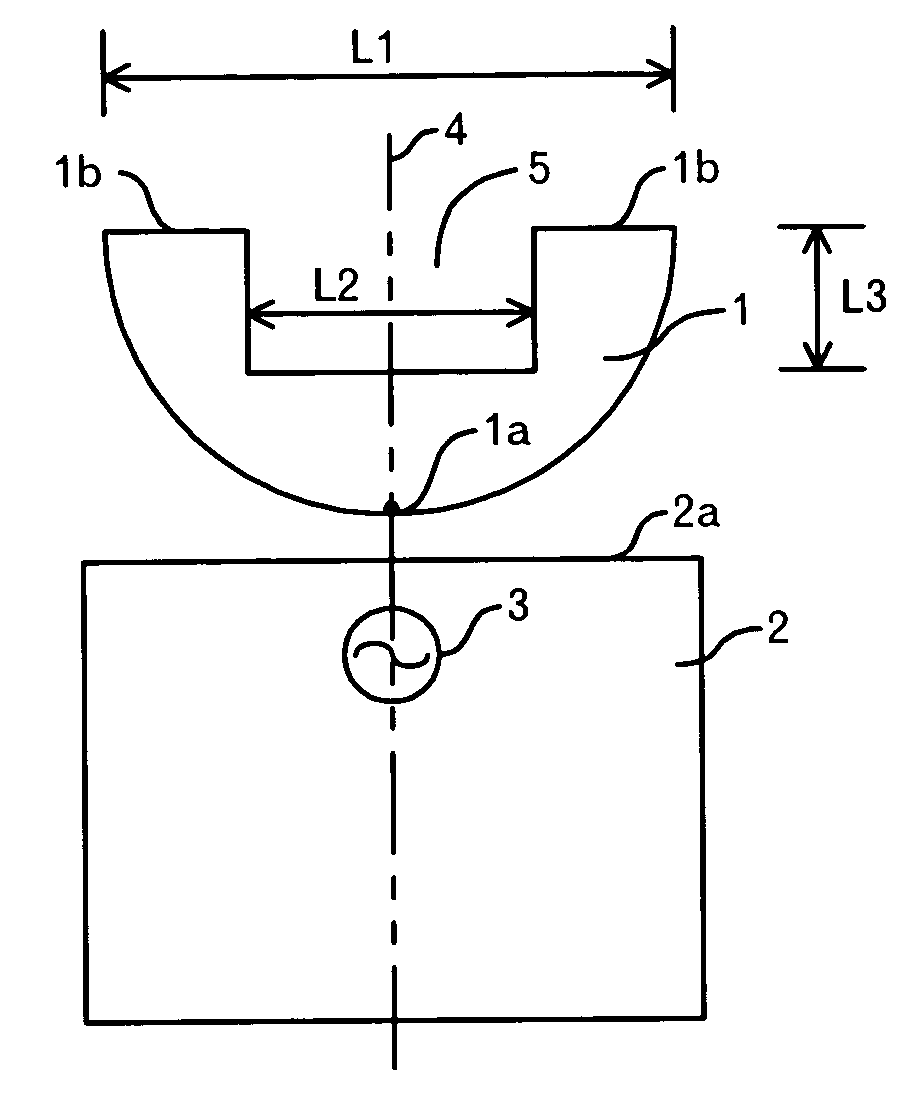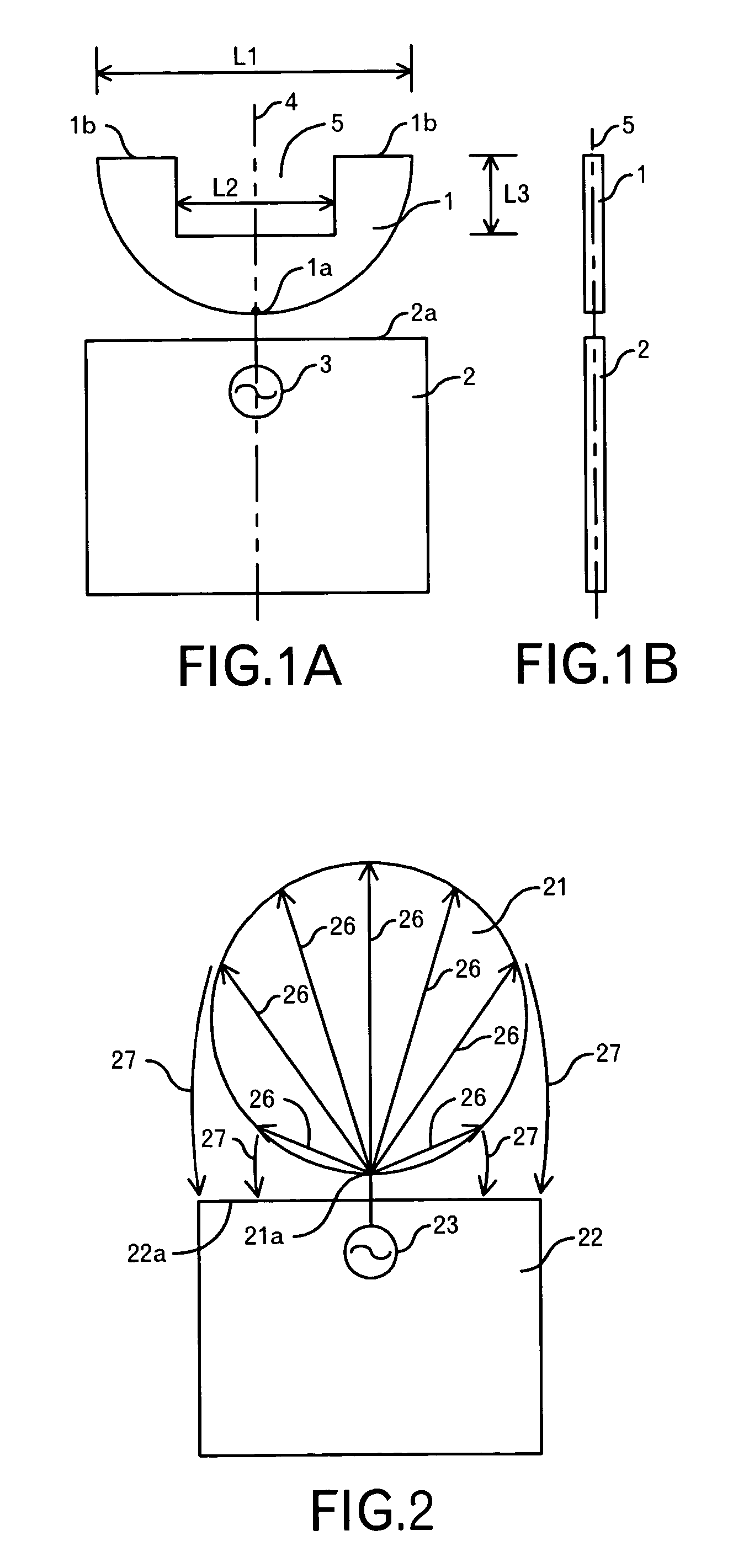Antenna and dielectric substrate for antenna
a dielectric substrate and antenna technology, applied in the direction of resonant antennas, antenna earthings, elongated active element feeds, etc., can solve the problems of difficult control of antenna characteristics, bad vswr characteristics, difficult to control antenna characteristics, etc., to achieve the effect of reducing the volume of the antenna, enhancing the miniaturization, and controlling the antenna characteristi
- Summary
- Abstract
- Description
- Claims
- Application Information
AI Technical Summary
Benefits of technology
Problems solved by technology
Method used
Image
Examples
first embodiment
1. First Embodiment
[0053]The structure of an antenna according to a first embodiment of the present invention is shown in FIG. 1A and FIG. 1B. The antenna according to this embodiment is composed of a planar element 1 formed of a semicircular conductive flat plate and having a cut-out portion 5, a ground pattern 2 juxtaposed with the planar element 1, and a high-frequency power source 3 connected to the feed point 1a of the planar element 1. The diameter L1 of the planar element 1 is set to 20 mm, for example. The aperture L2 of the cut-out portion 5 is set to 10 mm, for example, and the rectangular concavity whose depth is L3 (=5 mm) is formed from the top portion 1b (i.e. the edge portion farthest from the feed point 1a) of the planar element 1 toward the ground pattern 2 side, for example. The feed point 1a is located at such a position that the distance between the planar element 1 and the ground pattern 2 is shortest.
[0054]The planar element 1 and the ground pattern 2 are desig...
second embodiment
2. Second Embodiment
[0069]FIG. 6 shows the structure of an antenna according to a second embodiment of the present invention. In this embodiment, an example will be explained in which a planar element 41 which is formed of a semicircular conductive flat plate and is equipped with a cut-out portion 45, and a ground pattern 42 are formed on a printed circuit board (for example, a resin board formed of material such as FR-4, Teflon (registered trademark) or the like) having a dielectric constant of 2 to 5.
[0070]The antenna according to the second embodiment comprises the planar element 41, the ground pattern 42 juxtaposed with the planar element 41, and a high-frequency power source connected to the planar element 41. The high-frequency power source is omitted from the illustration of FIG. 6. The planar element 41 is equipped with a projecting portion 41a which is connected to the high-frequency power source and constitutes a feed point, a curved portion 41b opposite to a side 42a of t...
third embodiment
3. Third Embodiment
[0074]FIG. 8 shows the structure of an antenna according to a third embodiment of the present invention. In this embodiment, an example will be explained in which a planar element 51 which is formed of a rectangular conductive flat plate and equipped with a cut-out portion 55, and a ground pattern 52 are formed on a printed circuit board (FR-4, Teflon (registered trademark) or the like) having a dielectric constant of 2 to 5.
[0075]The antenna according to the third embodiment comprises the planar element 51, the ground pattern 52 juxtaposed with the planar element 51, and a high-frequency power source connected to the planar element 41. The high-frequency power source is omitted from the illustration of FIG. 8. The planar element 51 is equipped with a projecting portion 51a which is connected to the high-frequency power source and constitutes a feed point, a bottom side 51a opposite to a side 52a of the ground pattern 52, lateral side portions 51b connected vertic...
PUM
 Login to View More
Login to View More Abstract
Description
Claims
Application Information
 Login to View More
Login to View More - R&D
- Intellectual Property
- Life Sciences
- Materials
- Tech Scout
- Unparalleled Data Quality
- Higher Quality Content
- 60% Fewer Hallucinations
Browse by: Latest US Patents, China's latest patents, Technical Efficacy Thesaurus, Application Domain, Technology Topic, Popular Technical Reports.
© 2025 PatSnap. All rights reserved.Legal|Privacy policy|Modern Slavery Act Transparency Statement|Sitemap|About US| Contact US: help@patsnap.com



